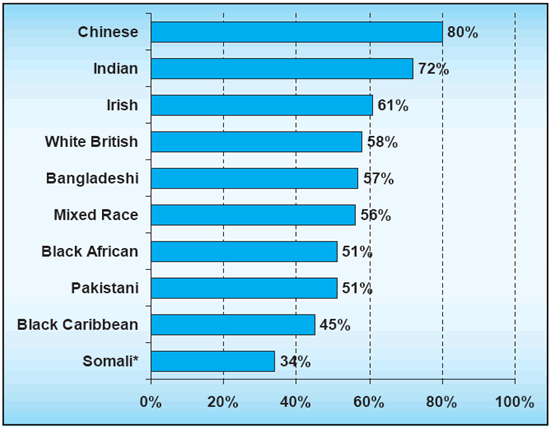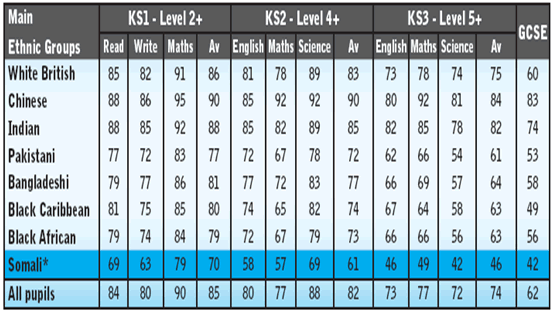fiogf49gjkf0d
by Mohamed Mukhtar
Friday, June 20, 2008
Somali children are still underachieving in British schools, according to new research led by led by Lambeth Council and commissioned by a London wide group of local authorities. The 108-page report has studied extensively the educational achievement of Somali pupils in ten London schools to identify good practice and strategies that can help Somalis to achieve higher standards. In London alone, it is believed that there are more than 35,000 Somali pupils in local authority schools.
The report acknowledges that Somalis pupils are underachieving compared to other ethnic groups. The report notes “The data from 10 London Local Authorities, with at least over 1000 Somali children in their schools, provides strong evidence that Somali pupils may generally be falling further behind the average achievement of the majority of their peers.” The following chart shows the GCSE performance of Somali pupils in 2006 compared to other ethnic groups (% of pupils gaining 5+ A* -C grades).

The report also looked into 2007 data to examine the performance of Somali pupils. The following chart presents performance data relating to key stages (KS) 1 to 4 and GCSE. For those who are not familiar with the British education system, here is a brief explanation of the UK national curriculum key stages: key stage 1 covers pupils aged 5-7; key stage 2 is 7 -11; key stage 3 is 11 -14; and key stage 4 is 14 – 16.

The report notes that as Somali pupils become older their level of achievement falls and it falls also in comparison to other groups. The report states:
• At Key Stage 1, 70% of Somali children were gaining level 2 or above compared to 86% of White British pupils, 79% of African pupils, 80% of Black Caribbean pupils and 88% of Indian pupils.
• At Key Stage 2, 61% of Somali children were gaining level 4 or above compared to 83% of White British pupils, 73% of African pupils, 74% of Black Caribbean pupils and 85% of Indian pupils.
• At Key Stage 3, 46% of Somali children were gaining level 5 or above compared to 75% of White British pupils, 63% of African pupils, 63% of Black Caribbean pupils and 82% of Indian pupils.
• At Key Stage 4, 43% of Somali children were gaining 5+A*-C compared to 60% of White British pupils, 56% of African pupils, 49% of Black Caribbean pupils and 74% of Indian pupils.
Despite this gloomy picture, the report finds some schools and pupils who are showing an impressive improvement in performance. For example, the research observes “In one primary school serving a deprived estate with a significant Somali population, there has been a dramatic rise in achievement over the last few years. Pupils enter the school with well below average starting points, yet in 2007 94% of pupils in the cohort achieved a level 4 or above in English and science.”
The report identifies several factors that have helped these Somali heritage students make significant educational improvements. The most important factors are: good leadership in the schools, Somali learning mentors, language support, parental engagement, environments that celebrate diversity, and innovative teaching methods.
Mohamed Mukhtar
[email protected]